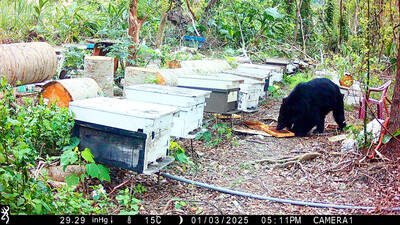The Ministry of Civil Service has denied 15 out of 38 applications for posthumous national pension payment for civil servants who died in the line of duty last year, saying that the circumstances surrounding the deaths did not meet legal requirements.
“Death in the line of duty” is defined by Article 5 of the Act Governing Civil Servants’ Retirement, Discharge and Pensions (公務人員退休資遣撫卹法), which states that for civil servants to be considered to have died in the line of duty, they must have perished on the battlefield; due to accidents during performance of job-related activities or due to inherent dangers of the job; following accidents or disease while on an official mission; after succumbing to a sudden onset of illness on the job, on official business or in their office; or due to overworking, accidents, dangers incurred or sudden health problems while traveling on official business.
Minister of Civil Service Chou Hung-hsien’s (周弘憲) yesterday told the Examination Yuan, that 282 civil servants passed away last year, 92 percent of whom died due to illness or accidents.
The ministry approved pension payments in 23 cases, Chou said.
The applications that were rejected were judged to be deaths from ordinary illness or accidents unrelated to the civil servants’ jobs, Chou said.
Chou said 12 cases involved deaths due to sudden onset of illness while on the job or in their office, while in a number of cases civil servants had died from sudden illness, accidents or dangers inherent to the job while traveling on public business.
Discretionary changes had been made to individual cases, Chou said, citing one case in which a late police officer’s pension was reduced to 25 percent.
The police officer died from sudden health issues while on patrol, Chou said, adding that the original application had cited death from duty-related dangers.
In another instance, a civil servant had died while delivering official documents to another office, Chou said.
The person’s heirs were eligible for a 10 percent one-off pension payment, but the ministry had judged the case to involve sudden illness while on duty, on official business or in the office and instead awarded them 15 percent of the original pension, he said.

SHIPS, TRAINS AND AUTOMOBILES: The ministry has announced changes to varied transportation industries taking effect soon, with a number of effects for passengers Beginning next month, the post office is canceling signature upon delivery and written inquiry services for international registered small packets in accordance with the new policy of the Universal Postal Union, the Ministry of Transportation and Communications said yesterday. The new policy does not apply to packets that are to be delivered to China, the ministry said. Senders of international registered small packets would receive a NT$10 rebate on postage if the packets are sent from Jan. 1 to March 31, it added. The ministry said that three other policies are also scheduled to take effect next month. International cruise ship operators

NUMBERS IMBALANCE: More than 4 million Taiwanese have visited China this year, while only about half a million Chinese have visited here Beijing has yet to respond to Taiwan’s requests for negotiation over matters related to the recovery of cross-strait tourism, the Tourism Administration said yesterday. Taiwan’s tourism authority issued the statement after Chinese-language daily the China Times reported yesterday that the government’s policy of banning group tours to China does not stop Taiwanese from visiting the country. As of October, more than 4.2 million had traveled to China this year, exceeding last year. Beijing estimated the number of Taiwanese tourists in China could reach 4.5 million this year. By contrast, only 500,000 Chinese tourists are expected in Taiwan, the report said. The report

The Forestry and Nature Conservation Agency yesterday launched a gift box to market honey “certified by a Formosan black bear” in appreciation of a beekeeper’s amicable interaction with a honey-thieving bear. Beekeeper Chih Ming-chen (池明鎮) in January inspected his bee farm in Hualien County’s Jhuosi Township (卓溪) and found that more than 20 beehives had been destroyed and many hives were eaten, with bear droppings and paw prints near the destroyed hives, the agency said. Chih returned to the farm to move the remaining beehives away that evening when he encountered a Formosan black bear only 20m away, the agency said. The bear

Chinese embassy staffers attempted to interrupt an award ceremony of an international tea competition in France when the organizer introduced Taiwan and displayed the Republic of China flag, a Taiwanese tea farmer said in an interview published today. Hsieh Chung-lin (謝忠霖), chief executive of Juxin Tea Factory from Taichung's Lishan (梨山) area, on Dec. 2 attended the Teas of the World International Contest held at the Peruvian embassy in Paris. Hsieh was awarded a special prize for his Huagang Snow Source Tea by the nonprofit Agency for the Valorization of Agricultural Products (AVPA). During the ceremony, two Chinese embassy staffers in attendance